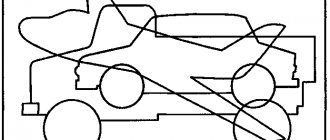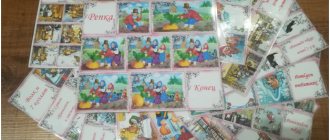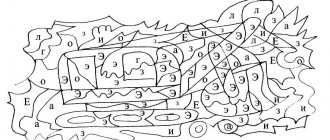Lexical and grammar lesson on the topic: “Vegetables”
Integration of educational areas:
- "Cognitive Development"
- “Socio-communicative development”,
- "Physical development"
Software tasks:
Speech development:
1. Consolidate and activate the vocabulary on the lexical topic “Vegetables”.
2. Exercise in the formation and use in speech of nouns with diminutive and augmentative meanings
3. Continue to teach how to answer the questions posed.
Cognitive development:
1. Develop observation, attention, thinking, coherent speech.
Social and communicative development:
1. Continue working to foster friendly relationships between children.
Physical development:
1. Develop fine motor skills of the fingers.
2. Develop the ability to coordinate speech with movements.
Equipment: subject pictures depicting vegetables, plot picture “Vegetable Garden”, vegetables (tomato, cucumber, cabbage, carrots, potatoes, onions, garlic, zucchini, eggplant, peppers, radishes, turnips, radishes, pumpkin).
Ecology lesson on the topic: Harvest. Preparatory group
Ecology lesson notes. Educational area "Cognition" for preparatory preschool age
TOPIC: “Harvest”
Program content: - introduce vegetables as a source of vitamins; — to form ideas about the importance of vitamins for human health; — expand your understanding of vegetables, the characteristics of their growth and storage; — to form ideas about the conditions for growing garden plants; - develop comparative thinking, the ability to construct a complete answer, perform imitative movements in accordance with the rules of the game; - develop the ability to move smoothly in accordance with the nature of the musical work, singing skills, musicality; — to cultivate respect for a person’s work in the garden, for the ability to achieve results; - cultivate a caring attitude towards your health; Equipment: presentation, handout pictures depicting vegetables, fly agaric, iron, earthworm, sausage, people, soundtrack of the song “In the garden or in the vegetable garden.” Introduction to the lesson: Teacher - Hello guys, I invite you to play a game. P/game (children stand in a circle, repeat the movements after the teacher) Children go to the garden, (marching) And there vegetables grow, (raise their hands up) Children tilt their backs, (lean over) They all collect vegetables (depict picking vegetables) He grew up with us garlic, (touch fingers when naming each vegetable) Pepper, tomato, zucchini Pumpkin, cabbage, potatoes, Onions and a little peas, We collected vegetables (clenching and unclenching fingers on both hands) We treated friends with them (pass vegetables to each other). Lesson: Teacher - And now we can sit down on the chairs. I think you have already guessed what we will talk about today. Children - About vegetables. Teacher - Well done. Please look at the screen. We have a guest today. Did you recognize him? Children - It's a bunny! Teacher - Yes. What's his mood? He loves vegetables very much, but does not know how to grow them. He had many questions. Can we help him solve them? Children - Yes! Teacher - How will you and I answer the questions? All in unison? And will we interrupt each other? Children - No. Teacher - Then let's agree that when a question appears on the screen, this is a signal for us to become very attentive. The answer will be the one I name. If one starts to answer, the others will listen to him and will not interrupt. Do you agree? Children - Yes. Teacher - Now we’ll count how many questions the bunny has. I will give you a signal to count the questions. One... (6 questions appear on the screen, the teacher and the children count them together). Questions surrounded the bunny and do not give him peace. Shall we help him solve them? Children - Yes. Teacher - Attention, first question: Why are vegetables needed? Children - They are useful. Vegetables contain vitamins. Teacher - Correct. Now we find out where they can be found? Teacher - In order not to deteriorate our eyesight, so as not to catch a cold, vitamin “A” will help us. Let's draw the letter "A" with our hands. But vitamins are called not in Russian letters, but in Latin and English. And today we will remember a few English letters. Where is vitamin A hidden? Children - In carrots. Teacher Remember the simple truth - Only those who chew raw carrots or drink carrot juice see better. Teacher - What is the name of the next vitamin? To prevent heart or stomach pain, vitamin “B” will help us. Let's draw the English letter B with our fingers. Together we will name the vegetables that contain vitamin B: Children - Radish, tomato, beet. Teacher - Another vitamin that helps us stay healthy is vitamin C. Let's see what vegetables it is found in. Children - Garlic. Teacher We don’t get the flu anymore We’re not afraid of drafts All the pills are replaced by a head of garlic. Teacher - There are also vegetables that contain a lot of vitamin C. We look at the screen and name them. Children - Onions, beets. Teacher - Let's see, if we answered the question correctly, it will disappear (the question disappears on the screen). Let's count how many questions are left. Children - Five. Teacher - Then the second question is - Where do vegetables grow? Children - In the garden. Teacher - What is the name of the place in the garden where vegetables are planted? Children - Garden bed. Teacher - Let's check if we did everything correctly. The question disappeared. How much is left? Children - Four. Teacher - And the bunny wanted to take a break from his questions and ask you riddles. The first riddle is very difficult. But I think you can handle it. Riddles He will borrow grain, and return the loaf. Children - Earth (if children have difficulty, they ask the question where we sow the grain). Teacher - Second riddle You warm the whole world You don’t know fatigue, You smile in the window, And everyone calls you... Children - The Sun. Teacher - Correct. And the last riddle from the bunny. The green meadows need me. The fields need me too. I water everything in the circle, When people have been waiting for me for a long time. Children - Water, rain. Teacher - Are you ready to help the bunny solve the third question? Children - Yes Teacher - How to grow vegetables? Children - We need to plant them and water them. Teacher - Correct. Another guest has come to you - a gardening gnome. He knows everything about the garden. Listen to the story about him: Once upon a time there lived a gardener. He planted a vegetable garden and carefully prepared the beds. He brought a suitcase full of different seeds, and began to plant them in order. Spring has come, And the seeds have sprouted - The gardener admired the seedlings. I watered them in the morning, covered them at night and protected them from the cold weather. Only patience and labor will bring us fruit. What did our gardener do? Children - Watered the garden, protected it from the cold, made a scarecrow to scare away the crows. Teacher - Well done, patience and work helped the gnome. Let's check that we did everything correctly. How many questions are left? Children - Three. Teacher - Before solving the fourth question, we will rest and play. I will show cards, if I show a card with a picture of a vegetable, you clap your hands, if I show a card with something that doesn’t fit, you jump in place. Outdoor game “What grows in the garden?” (during the game, children are shown cards with corresponding images; after the children answer, the cards are laid out in different directions) - Guess, guys, what is growing in our garden bed? — Green cucumber (“yes”) — Cheerful man (“no”) — Red tomato — Poisonous fly agaric — Onions — Or maybe an iron — Pot-bellied zucchini — Earthworm — Round radish — Delicious sausage. Teacher - Are you ready to answer the next question? Children - Yes. Teacher - What tools are needed for a garden? There are images of different instruments on the screen. We will choose those that will be useful to the bunny. Children - shovel, bucket, rake, watering can. Teacher - Let’s remove unnecessary tools. Children - Pliers, hammer, screwdrivers, lamp. Teacher - Let’s stand next to the chairs and depict how to use the tools (we imitate the movements). Teacher - let's check how many questions are left. Children - Two. Teacher - Here’s a question: What types of vegetables are there, how do they grow? Teacher - On the screen there are images of soil for vegetables - root crops. These are vegetables whose root and fruit are one and the same. But there are vegetables that ripen on the bush. Now we will distribute the vegetables to their places. If we do everything right, the bunny will shine. You will answer all together in unison, name the vegetable and where it lives. (children name vegetables and where they grow) Teacher - Bunny and Bambi love to play hide and seek. Do you find out what vegetables are hidden in the garden? In the garden there live root crops, whose root and fruit are the same. On the screen we see only the tops. What vegetable is hidden underground? (children take turns guessing the vegetables, the image appears) Teacher - Now let’s check whether we answered the question. Yes. How much is left? Children - One. Teacher - Before answering the last question, we need to gain strength. We'll play a game. Let's stand in a circle. Outdoor game One evening in the garden Turnips, beets, radishes, onions They decided to play hide-and-seek, But first they stood in a circle Calculated clearly right there One, two, three, four, five Better hide, hide deeper, Well, I’m going to look. Teacher - There are cards of vegetables in a circle on the floor in front of you. We do not pick them up, but carefully look at what is shown in the picture. Now the music will start playing, this is the Russian folk song “In the garden or in the vegetable garden”, you will walk around the cards in a circle, as soon as it ends you stop near the images. If the vegetable is a root vegetable, we squat; if the vegetable grows on a bush, then we remain standing and raise our arms up. Ready? Children - Yes. Teacher - Then they started (music plays, children walk in a circle, after the music stops, each depicts the vegetable they stopped in front of). Teacher - Look carefully at each other. Did we do everything right? (children make their own amendments). Let's try again? (repeat the game, the teacher and the children sing and dance in a circle). Teacher - Thank you guys. Now everyone will pick up their card and give it to me. Go to your seats. Teacher - How many questions do we have left? Children - One. Teacher - Where to store vegetables? Attention to the screen. The bunny wondered how people preserve vegetables for the winter. Children - In jars, in the basement, in the refrigerator (images of jars and a cellar appear on the screen). Teacher - Now pay attention, you answer with a complete answer. You know how to answer beautifully. You don't shout. I will name those who answer. Name the vegetable and where to store it. Children - (an image of vegetables appears on the screen, children take turns distributing them to places). Teacher - We check whether we helped the bunny or not. Look, the question disappeared and the bunny became happy. Well done, you helped the hare so well. All questions were answered. Teacher - The bunny is back. Why? We told him so much today that he forgot what vitamins are? Children - Vitamins are health benefits. Teacher - Where can I find them? Let's remember what vitamin is hidden in carrots? Children - Vitamin - A. Teacher - In a tomato? Children - Vitamin B. Teacher - In onions? Children - Vitamin C. Teacher - That's right, well done. The bunny asks - What would happen to us if we didn’t eat vegetables? Children - We would get sick, catch a cold, and see poorly (corresponding pictures appear on the screen). The teacher - the bunny wants to remember how the plants of the garden and the forest differ? In the picture we have a vegetable garden and a forest. But there are no vegetables in the garden and few trees in the forest. If we answer correctly, the pictures will change and become beautiful. What does a plant need to grow first? Children - Dig up the ground. Teacher - Who digs up the soil in the garden? How? Children - People, shovels, tools. Teacher - And in the forest, who loosens and digs up the soil? Children - Animals, mole, worm (after answers, images appear on the screen). Teacher - What is needed next for the plant to grow? Children - Seeds. Teacher - Who sows seeds in the forest? In the garden? Children - The wind sows seeds in the forest, people plant them in the garden (corresponding pictures appear). Teacher - What do plants need to grow? Children are the Sun. Teacher - How do people help garden plants keep warm? Children - Shelter, make greenhouses (images appear). Teacher - What do plants need besides the sun? Children - People water the garden with watering cans. It's raining (images). Teacher - if we answered everything correctly, the pictures will change (a forest with flowers, a garden with vegetables appears on the screen). Teacher - Guys, garden plants, in addition to sun and water, also need something very necessary from a person. What is this? What kind of people should they be if they care for plants? Children - Patience and work are needed. Teacher - The bunny is now joyful. Says thank you very much. Thanks to you, I now know what vegetables there are and how to grow them. I also say thank you very much. And I want to give you a small gift. The drawing consists of two parts, on one half of the leaf at the top there is a carrot drawn, here you need to find and color the vegetables that grow underground. On the second half at the top there is a cucumber, here you need to color those vegetables that are heated on the bush. But this is not a simple coloring, but an unusual one. When you complete this task, you will become more attentive, smarter, and more careful. You can go to the game room, take out colored pencils and color the pictures. Thank you guys very much.
We recommend watching:
Ecological conversation for children of the preparatory group Synopsis of a lesson on ecology for children of the preparatory group Synopsis of a lesson on ecology for children of the preparatory group of a preschool educational institution Work program for additional education in a preschool educational institution on ecology
Similar articles:
Lesson summary - fairy tales in the preparatory group of kindergarten
Summary of a lesson on ecology in the preparatory group. Plants on the territory of the kindergarten
Summary of a lesson on ecology in the preparatory group. Garden plants
Summary of a lesson on ecology in the preparatory group. Vegetable garden plants
Conversation “Take care of the forest” for preschool children of the senior preparatory group


